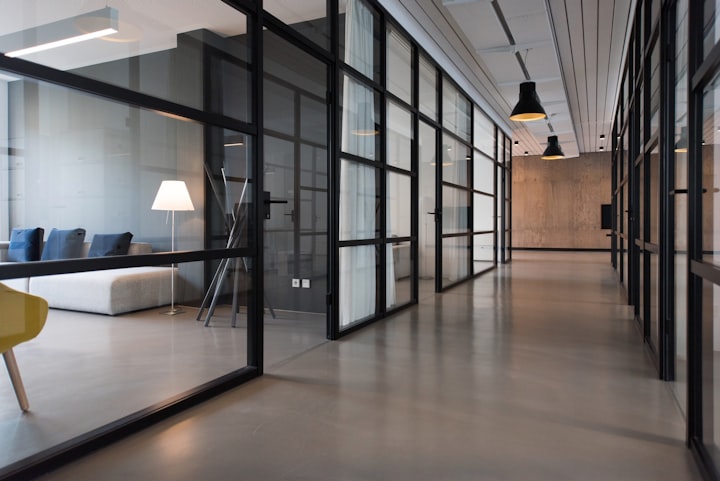The WFH Series: Redesigning and Rethinking the Office of the Future
How Will Office Design - and the Need for Offices Themselves - Change in the Wake of COVID-19?

For this management professor and consultant, one of the more fascinating aspects of the move to the “next normal” in the wake of the COVID-19 pandemic will be the changing nature of the office, both in function and in form. Certainly, during the course of the pandemic, employers and landlords were forced to largely improvise to make buildings “safer” for workers (instituting measures such as one-way walkways, eliminating desk and chairs for social distancing, providing lots of hand sanitizer, etc.). Many experts believe that having become accustomed to such measures, and out of both an abundance of caution and some trepidation, many of the temporary measures instituted over the past year may well be kept well into the future in offices and commercial buildings.
However, what will “the office of the future” look like? This is a huge topic of discussion today, as office design will certainly come to the forefront as we move to the “next normal.” A number of experts have put forth their visions for the office of the future, and one thing is for certain: There will be a flurry of experimentation and yes, remodeling of office spaces, in the months and indeed years to come. There are certainly some common themes in the predictions about what office designs will need to look like going forward. First, the idea of worker cubicles is a notion that will likely meet its final, and yes, well-deserved demise. Workers who can work in isolation in a cubicle, doing tasks that require isolation for concentration and productivity, will be far more likely to be shifted to a heavily remote work status than those who do not presently work in cubicles . Thus in many instances, a great deal of office floor space can, and should, be freed up with such a move.
“So you don’t want rows of little cubicle offices, you actually want the office to be primarily open, with communal space meeting rooms and some little offices for some quiet time. The old-school 1960s offices, the cubicle after cubicle — that kind of activity is done at home. So it’s almost the reverse of what it is right now. It’s illogical to come in just to use a cubicle.” ---- Stanford economist Nicholas Bloom
Secondly, the type of spaces that will become more and more important in offices with increased hybrid work arrangements will be those elements that allow employees to gather - and to gather safely – in groups of various sizes - based on the “why’s” of the gathering. As covered previously, as teams of workers are designated for days in the office, those days will largely be spent working with other team members in small groups. So, there will be a need for gathering spaces (yes, even beyond traditional conference rooms and break areas) to accommodate the number of employees who may be present on a given workday based on the members of teams being in the office on those designated days.
Thirdly, there will be a renewed emphasis on ventilation and access to fresh air. And as most of us know from visiting and working in modern office buildings, oftentimes, windows that can actually be opened are in very short supply. This will also mean that the world of HVAC will see significant business, as companies and landlords seek to provide ventilation to meet the needs and expectations of employers and workers today.
Finally, what is one of the more exciting areas of office design coming out of the pandemic is the whole notion of taking the office – and office activities - outdoors. As we all know from the pandemic experience, fresh air is important, and spacing and social distancing are much more easily done outdoors. However, present office designs often do not allow for employees to do anything more outdoors than perhaps eat their lunch outside. As Fast Company recently reported, there will be a significant push for landlords in building owners to accommodate the desire for more outdoor gathering and work spaces for organizations. This will lead to some likely fascinating design elements that will be incorporated into office designs in new buildings and in retrofitting older office buildings to allow for workers to meet, work and be productive outdoors. Certainly however, each area of the country will present its own unique challenges in this regard to accommodate the desire for more outdoor work spaces, given the climate of the locale. And even with the best design elements, such spaces may - and likely will - in most locales be subject to some “seasonality,” shall we say, in their utilization.
In the end however, this experienced management person is excited by the prospect that redesigning the workplace for better safety, efficiency, utilization, and yes, productivity, will bring in the new more hybrid-based workplace. Of course, as discussed in the preceding section, the changes necessary to enable offices to better cater to the hybrid work environment involve not just design elements, but the overall need for commercial office space. Sure, mistakes will be made, and some design elements, and sometimes very expensive design elements, will either end up not working or be “limited” in their feasible use (i.e. outdoor work spaces in Phoenix in the summertime or DC or New York City in the dead of winter). However, these “fits and starts“ will be necessary to develop best practices that can be used across industries and indeed across the country and around the world in designing offices for the next normal.
This researcher believes that the more offices can be made modular, flexible, and yes, safer in the future, this will lead to greater levels of employee productivity, but also improve worker morale and, in the end, worker retention. Thus, the investments that can and must be made in office environments, not just today, but over especially the next few years, will be an important physical corollary to the shift to a more hybrid work arrangement. In short, many of the design elements that are present in offices today will need to be seriously looked at for how they will work - or not work - in a more hybrid work environment. And executives will need to be willing to cast aside the “organizational inertia“ and their sometimes strong psychological ties to present office designs in order to experiment and make changes that will, in time, prove beneficial in a hybrid work environment.
++++++++++++++++++++++++++++++++++++++++++++++++++
About David Wyld
David Wyld is a Professor of Strategic Management at Southeastern Louisiana University in Hammond, Louisiana. He is a management consultant, researcher/writer, publisher, executive educator, and experienced expert witness. You can view all of his work at https://authory.com/DavidWyld.
Social Media Links to David Wyld:
About the Creator
David Wyld
Professor, Consultant, Doer. Founder/Publisher of The IDEA Publishing (http://www.theideapublishing.com/) & Modern Business Press (http://www.modernbusinesspress.com)






Comments
There are no comments for this story
Be the first to respond and start the conversation.